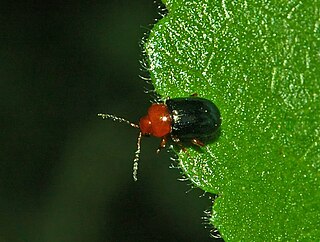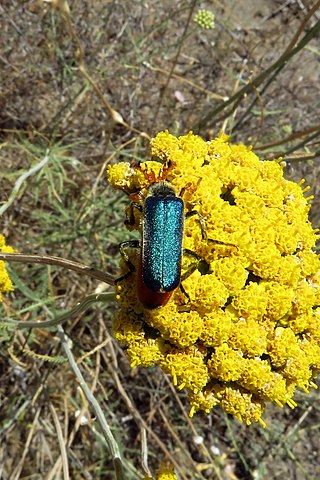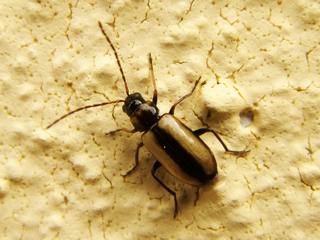Franz Faldermann was a German entomologist who specialised in Coleoptera.

Cerocoma is a Palearctic genus of blister beetle, whose biology is poorly known. As in other members of the family, these insects are hypermetamorphic. Larval hosts of few species were described. Imagines show distinct sexual dimorphism in the feeding apparatus and the antennae. All species in this genus have aposematic colouration.

Cheilotoma is a genus of beetles in the subfamily Cryptocephalinae of the leaf beetles family.

Podagrica is a genus of flea beetles belonging to the family Chrysomelidae. There are some 55 species in the Palaearctic, Oriental, and Afrotropical regions.

Nalassus is a genus of darkling beetles in the family Tenebrionidae. There are more than 70 described species in Nalassus, in the Palearctic and North America.

Mallosia, described by Étienne Mulsant in 1847, is a genus of longhorn beetles of the subfamily Lamiinae, tribe Saperdini. It is distributed in the Palearctic, from Greece to Caucasus and Iran.

Dorcadion is a genus of longhorn beetles of the subfamily Lamiinae.

Phytoecia is a genus of longhorn beetles of the subfamily Lamiinae,
Dorcadion glaucum is a species of beetle in the family Cerambycidae. It was described by Faldermann in 1837. It is known from Azerbaijan and Iran.
Dorcadion laeve is a species of beetle in the family Cerambycidae. It was described by Faldermann in 1837. It is known from Iran, Armenia, and Turkey.
Dorcadion indutum is a species of beetle in the family Cerambycidae. It was described by Faldermann in 1837.
Mallosia mirabilis is a species of beetle in the family Cerambycidae. It was described by Faldermann in 1837. It is known from Iraq, Turkey and Iran.
Phytoecia diademata is a species of beetle in the family Cerambycidae. It was described by Faldermann in 1837. It is known from Iran, Turkey and the Caucasus Mountains.
Phytoecia faldermanni is a species of beetle in the family Cerambycidae. It was described by Faldermann in 1837. It is known from Russia, Azerbaijan, Kazakhstan, Armenia, Georgia, and Ukraine.

Phytoecia puncticollis is a species of beetle in the family Cerambycidae. It was described by Faldermann in 1837. It is known from Russia, Azerbaijan, Georgia, Iraq, Armenia, Turkey, Iran, and Turkmenistan. It feeds on Eryngium billardierei.
Tetrops gilvipes is a species of beetle in the family Cerambycidae. It was described by Faldermann in 1837, originally under the genus Anaetia. It has a wide distribution in Europe. It feeds on Pyrus communis.

Labidostomis is a genus of short-horned leaf beetles belonging to the family Chrysomelidae, subfamily Cryptocephalinae.

Cerocoma festiva is a species of blister beetle in the family Meloidae.

Calomicrus is a genus of beetles belonging to the family Chrysomelidae.

Diorhabda is a genus of beetles in the family Chrysomelidae. The beetles feed on Tamarix The genus is native to Europe and Asia, but several species have been intentionally introduced to North America as biological control agents for Tamarix. Common names include tamarisk beetle and saltcedar leaf beetle.











